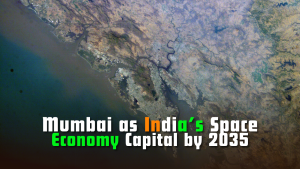Daily Current Affairs 19th July 2025
In this edition of Daily Current Affairs, we bring you concise and important updates on key national and international developments that are shaping the world today.
1) Ports and India’s Economic and Strategic Aspirations
2) Enhancing Counter-Terrorism in Jammu & Kashmir
3) Open Network for Digital Commerce: A Bold Leap Toward E-Commerce Democracy
4) China’s ‘silent war’
5) India’s Regulatory Response to Antibiotic Misuse in Food Animal Production
6) Gravitational Waves from the Largest Black Hole Merger
7) Place in News: Eswatini
8) India’s Low-Carbon Development Strategy: A Long Overdue Shift Toward Net Zero
Ports and India’s Economic and Strategic Aspirations
Securing Indian Ports
Context: Ports form the backbone of a nation’s economic growth by serving as critical gateways for international trade.
More on News
- For India, the strategic positioning of its ports across the Indian Ocean Region (IOR) connects it to over 150 countries, reinforcing its potential as a major global maritime hub.
- However, as India pushes for port digitisation under various national initiatives, these assets are increasingly exposed to modern threats—especially cyberattacks, including espionage, hacktivism, and ransomware.
- Rising geopolitical tensions, particularly China’s growing digital and maritime influence, have magnified the threat landscape.
- In 2020, suspected Chinese hackers targeted Indian ports, and during Operation Sindoor, India faced a wave of state-sponsored cyber intrusions aimed at its critical infrastructure.
Why Are Indian Ports Becoming Increasingly Vulnerable to Cyberattacks?
- Rising Cyberattacks: From the Port of Nagoya (Japan, 2023) to JNPT (India, 2017) and the Port of Lisbon (Portugal, 2022), ransomware incidents have disrupted terminal operations, exposed sensitive data, and caused major economic setbacks.
- According to the DNV Maritime Cyber Priority Survey 2024/25, 31% of maritime professionals reported at least one cyberattack between October 2023 and October 2024.
- India’s Push: India’s aggressive digitisation push—while enhancing port efficiency—has inadvertently expanded the cyberattack surface, especially as Information Technology (IT) systems converge with Operational Technology (OT).
- Key infrastructure like SCADA systems, which monitor power and cargo, now face elevated risks.
- Advanced Persistent Threats (APTs) are exploiting this gap through DDoS attacks, spear-phishing, and ransomware-as-a-service models.
What Digital Measures Have Been Taken to Modernise Indian Ports?
- Sagarmala: India’s port ecosystem includes 12 major and over 200 minor ports, forming the bedrock of its maritime trade.
- Under the Sagarmala Programme, the government is promoting smart port operations, AI-based logistics, and real-time cargo tracking.
- The Sagarmala Startup and Innovation Initiative (S2I2) also encourages maritime innovation in green shipping and port management.
- MIV 2030: Moreover, the Maritime India Vision 2030 (MIV 2030) and Amrit Kaal Vision 2047 envision the creation of mega ports and transshipment hubs, backed by digital innovation.
- ULIP: Projects like the Unified Logistics Interface Platform (ULIP) and collaborations between the Indian Ports Association (IPA) and the National e-Governance Division aim to strengthen port digitisation and operational integration.
What Are the Existing Cybersecurity Measures for Indian Ports?
- Early Steps: A key initiative is the MoU between IIT-Kanpur and the IPA, focusing on digital security, training, and management systems for ports.
- Port-specific cybersecurity workshops by institutions like Rashtriya Raksha University and training programs by the Cochin Port Authority reflect an evolving institutional response.
- Cyber Resilience: On the regional front, India is working through the Colombo Security Conclave with Sri Lanka, Maldives, and Mauritius to promote joint cyber resilience.
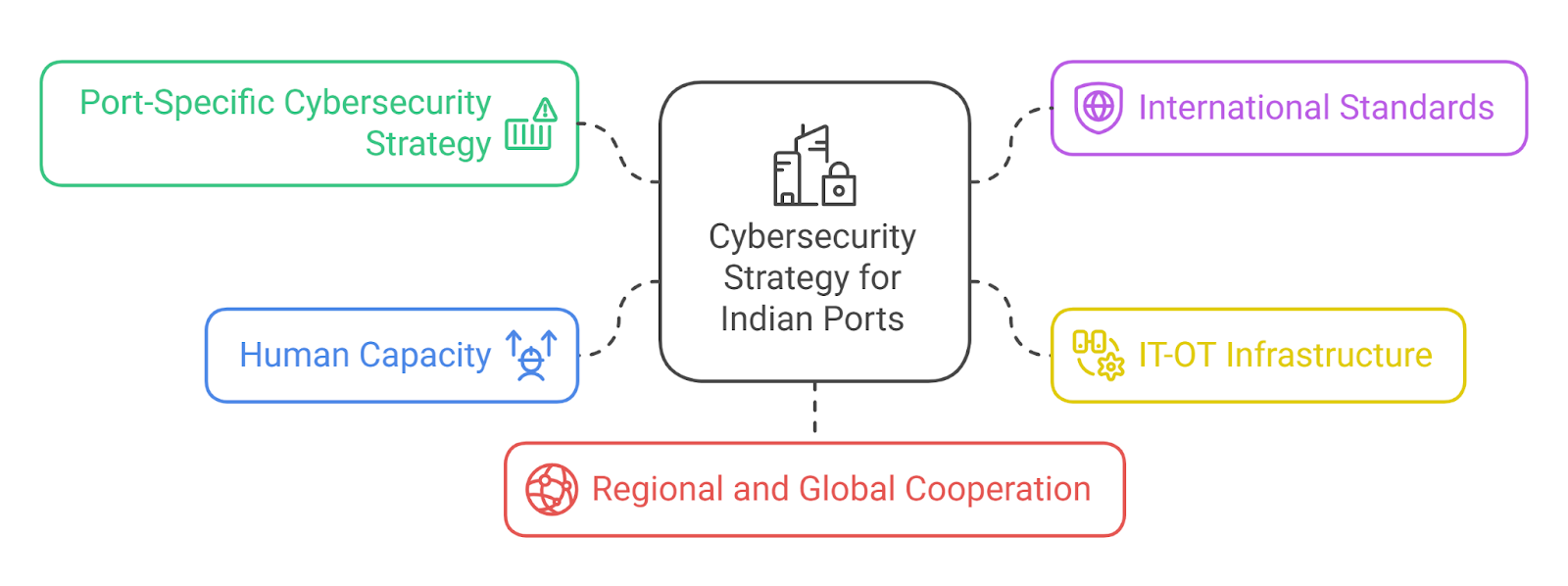
What Are the Key Gaps in India’s Maritime Cybersecurity Framework?
- The MIV 2030 focuses on port digitisation but lacks a dedicated cybersecurity pillar.
- India’s broad cyber laws—the IT Act, 2000 and the Cybersecurity Policy, 2013—do not offer port-specific protocols, unlike countries such as the U.S. (National Maritime Cybersecurity Plan, 2020) and the U.K. (National Strategy for Maritime Security, 2022).
- Additionally, while institutions like CERT-In, Cyber Swachhta Kendra, and the Indian Cyber Crime Coordination Centre contribute to national cyber preparedness, they lack a tailored focus on the maritime sector.
Why Is a Maritime Cybersecurity Strategy Critical for India?
- With escalating cyber threats globally—e.g., ransomware attacks at Shahid Rajaee (Iran), Kennewick (US), and South Africa’s major ports—India must develop a dedicated maritime cybersecurity strategy.
- Attacks like the JNPT ransomware incident (2022) and breaches in Australia’s DP World (2023) illustrate how port systems are prime targets.
- A successful cyberattack could cripple military logistics, halt trade flows, or even manipulate cargo data for illicit trade and smuggling.
- Therefore, cybersecurity can no longer be an afterthought in India’s port development plans.
Enhancing Counter-Terrorism in Jammu & Kashmir
Context: The Lieutenant Governor of Jammu & Kashmir urged the J&K Police (JAKP) to adopt modern technology, prevent radicalisation, and work in collaboration with communities to effectively tackle security threats.
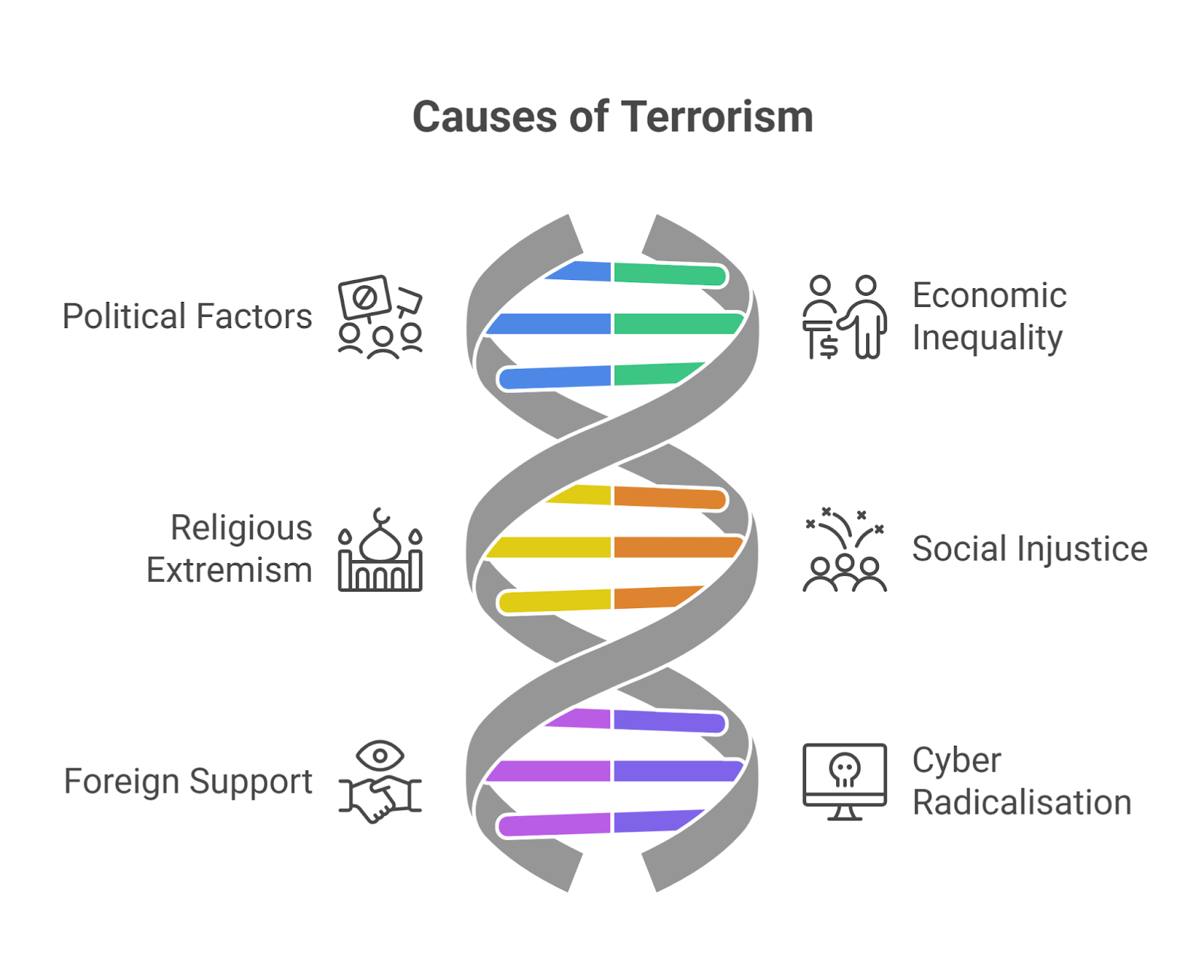
Why Is the J&K Police a Crucial Asset in Counter-Terrorism?
- Unlike central armed forces, the JAKP has intimate knowledge of the local terrain, demography, and community dynamics, which is critical in identifying and neutralising threats.
- Their proximity to the local populace allows for stronger human intelligence (HUMINT) capabilities—an advantage that cannot be replicated by external forces.
- The April 22, 2025, Pahalgam terror strike serves as a grim reminder of the potential consequences of HUMINT failure.
Should Elected Governments Control the J&K Police?
- To strengthen the effectiveness of the JAKP, it is essential to restore its functional accountability to an elected government.
- Currently, the police operate under the command of the Lieutenant Governor, which undermines democratic oversight and distances local representatives from the security architecture.
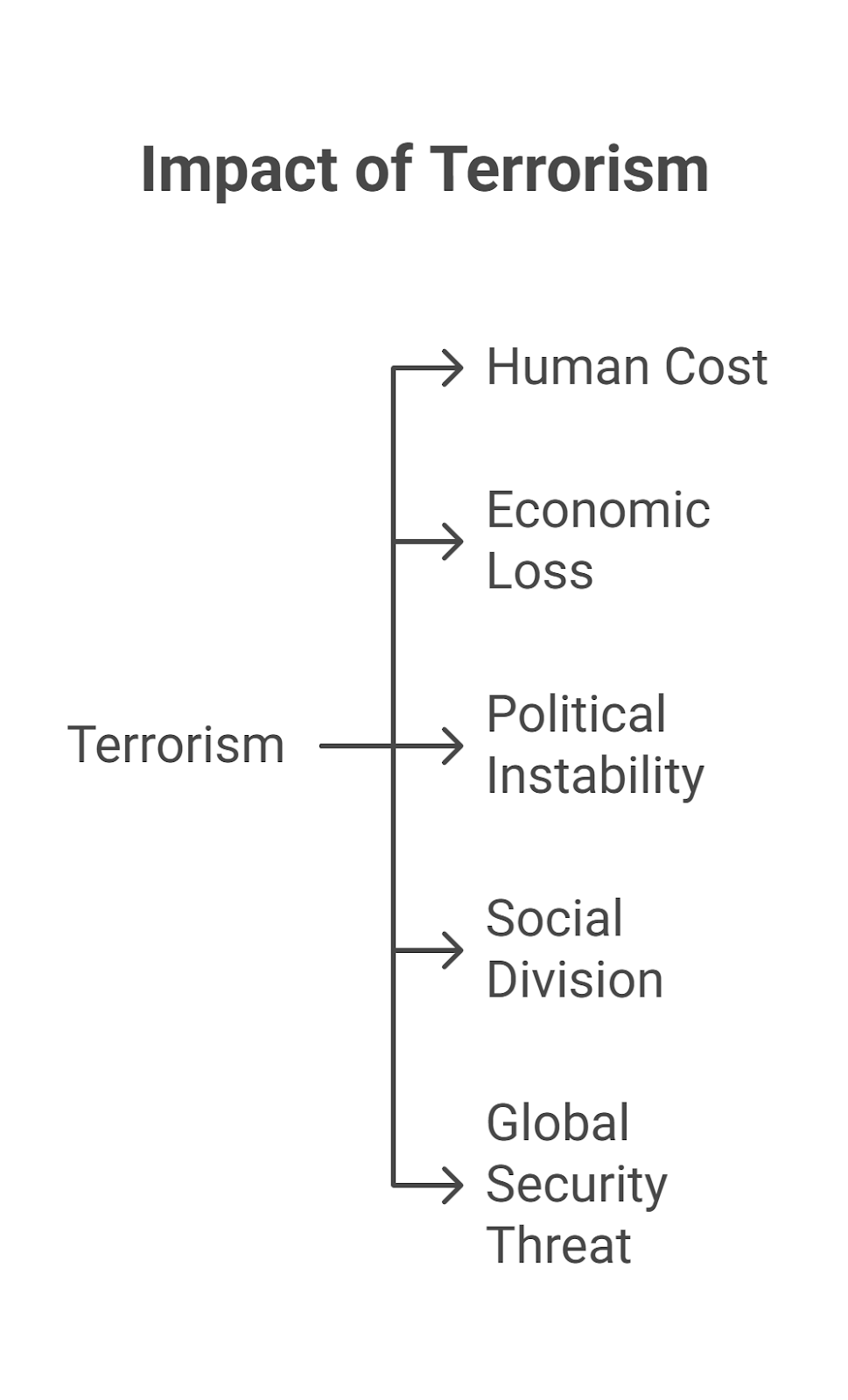
What Role Do Local Representatives Play in Ensuring Security?
- Elected representatives are naturally more trusted by the local population, and their grassroots networks can serve as invaluable sources of intelligence.
- Information about terrorist movements and overground workers is more likely to be shared with these community leaders than with central agencies.
Why Is Restoring Participatory Governance Essential in J&K?
- J&K has a rich democratic tradition, particularly at the grassroots level.
- However, due to persistent security concerns, local representatives have remained largely symbolic.
- Empowering them constitutionally and operationally will enable a tiered governance system, where the JAKP works hand-in-hand with all levels—from panchayats to Parliament.
- This collaborative model will encourage a structured police-community dialogue, facilitating better intelligence gathering, public trust, and localised counter-terrorism strategies.
Comprehensive Convention on International Terrorism (CCIT)
Proposed by India in 1996, its objectives include establishing a universal definition of terrorism, banning all terror groups, enforcing prosecution under special laws, and making cross-border terrorism an extraditable offense. Negotiations are stalled due to disagreements among countries, particularly over the definition of terrorism and its applicability to state actors and self-determination movements.
How Can Community-Police Partnerships Improve Security?
- Embedding elected leaders into the security framework will help bridge the trust deficit between law enforcement and the public.
- A participatory model of governance, rather than a top-down elitist one, is essential for building long-term peace and stability in the region.
What are the Steps Taken by India to Counter Terrorism?
- Legal Measures: Unlawful Activities (Prevention) Act (UAPA), 1967, National Investigation Agency (NIA), 2008 and Amendment to UAPA (2019).
- Military & Intelligence Measures: Surgical Strikes (2016) & Balakot Airstrike (2019) and Multi-Agency Centre (MAC).
- Financial Measures: Financial Intelligence Unit (FIU), Demonetisation (2016).
- International Cooperation: Pushes for global action at UN, FATF (blacklisting Pakistan) and Bilateral agreements with US, Israel, and EU on counter-terrorism.
What are the Global Efforts Against Terrorism?
- United Nations (UN) Measures: Global Counter-Terrorism Strategy (2006), UNSC Resolution 1267 (1999) and Financial Action Task Force (FATF).
- Regional Initiatives: Shanghai Cooperation Organisation (SCO), Global Coalition to Defeat ISIS.
- Technological Measures: AI-driven surveillance to detect online radicalisation and Interpol’s Fusion Task Force tracks foreign fighters.
What is the Way Forward?
- Strengthen Intelligence Sharing: Enhance global cooperation (e.g., Interpol, BRICS).
- Counter Radicalisation: Community engagement, deradicalization programs.
- Strict Financial Controls: Crack down on hawala, crypto-funded terrorism.
- Adopt CCIT: Push for consensus at the UN.
- Tech-Driven Solutions: Use AI to monitor dark web activities.
- Address Root Causes: Poverty alleviation, inclusive development.
Open Network for Digital Commerce: A Bold Leap Toward E-Commerce Democracy
Open Network for Digital Commerce: Unlocking India’s Digital Retail Revolution
What is ONDC?
ONDC (Open Network for Digital Commerce) is a government-backed open protocol-based digital commerce network launched in April 2022. It aims to democratise e-commerce by unbundling operations (like search, listing, order management, logistics, and payments), much like how UPI revolutionised digital payments.
- Incorporated as: Section-8 not-for-profit company (2021)
- Promoted by: Department for Promotion of Industry and Internal Trade (DPIIT), Ministry of Commerce and Industry
- Orchestrated by: Quality Council of India (QCI)
- Authorised capital: ₹500 crore (Govt. + major banks like SBI, PNB, Kotak Mahindra, Axis Bank, etc.)
Why was ONDC launched?
- ONDC was launched to restructure India’s monopolised digital commerce ecosystem, dominated by vertically integrated platforms like Amazon and Flipkart, which:
- Control seller onboarding, customer interface, delivery, and payments
- Charge high commission fees (15–35%)
- Create entry barriers for MSMEs
-
Key Objectives
- Democratise digital commerce through platform-neutral access
- Empower MSMEs and artisans with equal digital visibility
- Enhance consumer choice via interoperable buyer-seller interactions
- Promote local commerce for Atmanirbhar Bharat
- Reduce digital inequality by onboarding Tier 2/3 towns and rural participants
Where is ONDC implemented?
- Cities: Over 616 cities, including metros, Tier 2/3 towns, and rural clusters
- Rural Push: Integration with Common Service Centres (CSCs) and pilot in Fair Price Shops (Himachal Pradesh)
- Domains Supported (13+): Retail (FMCG, Fashion, Electronics), Food & Beverages, Agriculture (via e-NAM), Financial Services (credit, insurance), Mobility (cab booking, metro), Healthcare & Wellness & Education & Skilling (via ONEST platform).
- Example: Rural artisans in Varanasi onboarded via ONDC-compatible apps can sell pan-India without depending on Flipkart or Amazon.
Who are the key stakeholders of ONDC?
A. Government & Public Agencies:
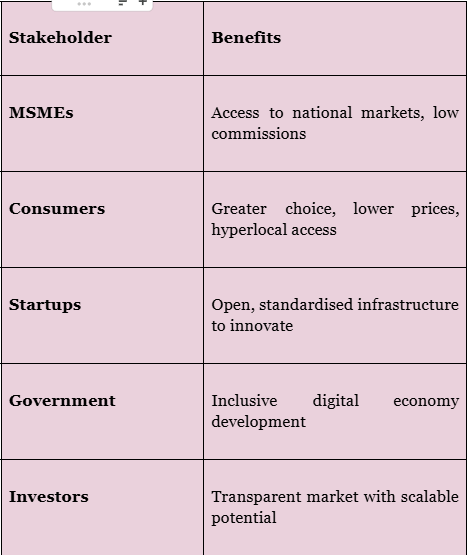
- DPIIT, QCI, NABARD, Ministry of MSME, Ministry of Agriculture
- ONDC Ltd. manages protocol standards
-
Private Participants:
- Buyer Apps: Paytm, Magicpin, Pincode, Meesho
- Seller Apps: Growth Falcons, Mystore, eSamudaay, GOFRUGAL
- Logistics: Dunzo, LoadShare, Delhivery
- Financiers: SBI, Axis Bank, HDFC, YES Bank
What are the technological features of ONDC?
- Open Network Protocols: Similar to HTTP/SMTP
- Platform Interoperability: Any buyer can transact with any seller
- No Data Centralisation: ONDC does not store transaction-level data
- Sector and Technology Agnostic
- Scalable Architecture: Open APIs allow modular, plug-and-play growth
- Multi-lingual Support: Enabled via Bhashini for regional inclusion
What is ONDC’s significance for India’s digital and economic growth?
- Digital Public Infrastructure: Complements UPI, Aadhaar, DigiLocker
- Level Playing Field: Counters monopolistic practices and self-preferencing
- Lower Cost to Sellers: Reduces commission from 30% to ~3–5%
- Employment Generation: Through support to artisans, FPOs, kiranas
- Global Diplomacy: Offers a replicable model for Global South nations
What policy support enables ONDC adoption?
- Mandate ONDC integration for GeM, e-NAM
- Link government procurement with ONDC listing
- Offer tax and credit incentives for ONDC-aligned startups
China’s ‘silent war’
China’s Export Curbs on Rare Earth Elements
Context: In April 2025, China introduced new export restrictions on seven rare earth elements and magnets—samarium, gadolinium, terbium, dysprosium, lutetium, scandium, and yttrium—key components in defence, energy, and automobile sectors.
More on News
- These curbs came in the wake of the US tariff war led by President Donald Trump.
- The new rules require companies to obtain special export licences, intensifying bureaucratic burdens and compliance hurdles.
- This move is part of China’s strategy to weaponise its dominance over the global rare earths market, highlighting the West’s dependency on Chinese minerals essential for the production of electric vehicles, wind turbines, and military aircraft.
What Are China’s Broader Strategic Goals Behind Export Restrictions?
- Not Limited to Rare Earths: Following the 2024 U.S. presidential election, Beijing had already restricted exports of tungsten, graphite, magnesium, and aluminium alloys used in high-tech manufacturing.
- In response to technological sanctions during Joe Biden’s presidency, China also curbed exports of gallium and germanium—essential for semiconductors and electronics.
- Countering Economic Coercion: By December 2024, China implemented a full ban on gallium and germanium exports, intensifying the technology standoff with the West.
How Is China’s Export Control Law Shaping Global Trade?
- China’s Export Control Law, enacted in December 2020, grants the state sweeping powers to regulate the outflow of strategic technologies and materials.
- It mandates official clearance for exports and allows the state to retaliate against countries that harm its national security or “interests.”
- Notably, the inclusion of the term “interests” gives the government greater discretion in imposing restrictions.
- This legal shift aligns with President Xi Jinping’s national security vision, where integration into global supply chains is seen as a strategic buffer against foreign pressure.
- The formation of China Rare Earth Group in 2021—through mergers of giants like Aluminium Corporation of China and Minmetals—further centralised Beijing’s grip on the critical minerals sector.
What Is the Impact of China’s Rare Earth Curbs on India?
- India has already started feeling the heat. Electric vehicle manufacturers in India report that Chinese restrictions on rare earth magnets are disrupting production schedules.
- This illustrates how the interlinkage between economic and national security is becoming more visible in today’s globalised world.
- During the 2025 BRICS Summit in Brazil, Prime Minister Narendra Modi raised concerns about the weaponisation of critical resources.
- Emphasising the need for secure and reliable global supply chains, the PM implicitly called out China’s use of resource control as a geopolitical tool.
How Is India Responding to the Strategic Minerals Challenge?
- Self-Reliance and Strategic Collaboration: In 2025, it launched the National Critical Mineral Mission to boost domestic capabilities and streamline its policy framework for critical minerals.
- Plans are underway to establish a Centre of Excellence on Critical Minerals to update mineral lists and coordinate national strategy.
- Quad Critical Minerals Initiative: At the Quad Foreign Ministers’ Meeting in Washington (July 2025), India supported the Quad Critical Minerals Initiative to diversify and secure global mineral supply chains.
- The initiative promotes investment, e-waste recycling, and reprocessing of critical minerals with the involvement of private players.
- Global Partnerships: At the G7 Summit in Canada (June 2025), India backed the Critical Minerals Action Plan.
- The G7 finance ministers pledged $50 million under the Resilient and Inclusive Supply Chain Enhancement initiative, which includes Japan, Germany, Canada, South Korea, Italy, and the UK.
-
- These multilateral initiatives aim to reduce over-reliance on China, protect against economic coercion, and build sustainable supply chains for the future.
India’s Regulatory Response to Antibiotic Misuse in Food Animal Production
India strengthens regulations for antibiotic use in food animal production amid export norms & global AMR concerns
Context: India has tightened rules on antibiotic use in food animals, banning 34 antimicrobials to combat global antimicrobial resistance (AMR) and meet EU export standards. The move curbs misuse and aligns India with international food safety norms.
Background
- Antimicrobial Resistance (AMR) is a growing global health threat, driven by the misuse and overuse of antibiotics in food animal production.
- Antibiotics are used not only for treatment but also for non-therapeutic purposes like disease prevention and growth promotion.
- Residual antibiotics in exported animal products (meat, milk, eggs, etc.) pose public health risks and trade barriers.
How Does AMR Spread from Animals to Humans?
- Direct contact with animals or farm environments.
- Consumption of animal products with antimicrobial residues.
- Environmental contamination from animal waste containing resistant microbes.
- Cross-resistance, where microbes acquire resistance to multiple drugs, impacts both animal and human health systems.
Why is it a Concern?
- AMR causes 1.2 million deaths annually in India, with projections of up to 10 million globally by 2050.
- Overuse of antibiotics in livestock leads to superbugs that compromise human treatments.
- The EU’s stringent import regulations demand compliance with antimicrobial standards, affecting India’s export potential.
What Are the EU Regulations?
- Regulation (EU) 2019/6: Prohibits antimicrobials for growth promotion and routine use in poor farm conditions.
- Regulation (EU) 2022/1255: Reserves 37 antimicrobials (including 18 antibiotics) for human use only.
- Regulation (EU) 2023/905: Requires exporting countries to comply with antimicrobial restrictions.
- Regulation (EU) 2024/2598: Lists authorised countries for animal product exports; India is not yet listed.
What Steps Has India Taken?
- Central Drugs Standard Control Organisation (CDSCO) and DTAB Actions:
-
- In April 2025, the Drugs Technical Advisory Board (DTAB) recommended prohibiting 34 of 37 antimicrobials listed by EU Regulation 2022/1255.
- In May 2025, the Ministry of Health and Family Welfare (MoHFW) notified the ban on manufacture, sale, import, and distribution of these 34 antimicrobials:
-
- 15 antibiotics/groups, 18 antivirals, and 1 antiprotozoal.
- Of these, six are individual antibiotics, and nine are classes of antibiotics listed as medically important antimicrobials by WHO (2024).
-
- Ban on Specific Antibiotics Over Time:
-
-
- March 2025: MoHFW banned chloramphenicol, nitrofurans, and related formulations.
- 2019: Ban on colistin and its formulations in food-producing animals, including aquaculture.
-
- Food Safety and Standards Authority of India (FSSAI):
-
- October 2024: Banned antibiotics across the production chain (rearing to processing) in milk, meat, poultry, eggs, aquaculture, and honey.
- Prohibited substances include: Three antibiotic classes (Glycopeptides, Nitrofurans, Nitroimidazoles), and five antibiotics (Carbadox, Chloramphenicol, Colistin, Streptomycin, Sulfamethoxazole).
- Coastal Aquaculture Authority (March 2024): Issued revised guidelines (replacing 2005 norms). Banned five antibiotic classes and five individual antibiotics used in coastal aquaculture for exports.
- Ministry of Commerce (May 2025): Banned 12 antibiotic classes and six individual antibiotics in aquaculture exports (especially to the EU and US) to align with the EU’s reserved list.
Where Does India Stand in EU Authorisation?
- As of now, India is not on the EU’s list of authorised countries for export of food animal products under Regulation (EU) 2024/2598. To gain inclusion:
- India must provide evidence of compliance with EU antimicrobial prohibition norms.
- Must issue specific attestations with every consignment.
- Deadline: 3 September 2026 to avoid disruption in exports.
Challenges and Way Forward
- Weak Surveillance Systems: Lack of reliable data hampers effective policymaking and risk assessment.
- Poor Farm Management: Inadequate hygiene, overcrowding, and weak biosecurity increase disease burden and antibiotic dependence.
- Promote Good Husbandry: Improve animal housing, ventilation, and reduce stress during transport.
- Breed Disease-Resistant Livestock: Encourage use of locally adapted or genetically resistant breeds.
- Strengthen Preventive Healthcare: Expand vaccination and disease surveillance to reduce infection risk.
Gravitational Waves from the Largest Black Hole Merger
How scientists detected a colossal merger of black holes
Context: Scientists detected gravitational waves from the collision of two massive black holes located 10 billion light-years away.
What are Gravitational Waves?
- Gravitational waves are ripples in spacetime caused by the movement of massive objects, similar to ripples produced by a boat moving in water.
- Predicted by Albert Einstein’s General Theory of Relativity (1915) but first detected only in 2015 by LIGO (Laser Interferometer Gravitational-Wave Observatory).
- Extremely weak; only detectable when produced by massive cosmic events like black hole mergers.
What is the Latest Discovery?
- Scientists detected gravitational waves from the merger of two massive black holes, the largest observed so far in such an event.
- The two black holes had masses:
-
- Black Hole 1: 140 times the mass of the Sun
- Black Hole 2: 100 times the mass of the Sun
- The merger resulted in a new black hole ~225 times the Sun’s mass, releasing enormous energy as gravitational waves.
- Previous record (2021): Merged black holes of 80 and 65 solar masses.
Why is This Discovery Significant?
- Challenges existing theories: Black holes in the 100-150 solar mass range were not expected to exist. Current models suggest stars that could form such black holes usually end differently (e.g., explode without collapsing into black holes).
- Unusual spin observed: At least one black hole was spinning near the maximum limit allowed by Einstein’s theory.
- Potential to refine scientific understanding: Black hole formation, Stellar evolution, Possible revisions to cosmological models.
How Do Gravitational Waves Help Study the Universe?
- Before 2015, scientists relied on electromagnetic waves (light, X-rays, radio waves).
- Limitations of traditional methods: Dark matter & dark energy (95% of the universe) do not interact with electromagnetic waves. Black holes were previously “invisible” to telescopes.
- Advantages of gravitational waves: Provide information about cosmic events that do not emit light. Offer a new tool to study black holes, neutron stars, and other massive phenomena.
How Are Gravitational Waves Detected?
- LIGO (USA): First to detect gravitational waves in 2015.
- Global collaboration (LVK): Virgo (Italy), KAGRA (Japan)
- Future expansion: LIGO-India (Hingoli, Maharashtra). Approved in 2023 with a budget of ₹2,600 crore. Originally planned for 2024, now expected to be completed by April 2030.
What Does This Mean for Future Research?
- Opens new avenues to study black holes, neutron stars, and cosmic evolution.
- May lead to new physics beyond Einstein’s General Relativity.
- Enhances understanding of dark matter and dark energy.
Conclusion
The detection of gravitational waves from the largest black hole merger yet challenges existing astrophysical theories and provides a new way to explore the universe. With upcoming observatories like LIGO-India, scientists hope to uncover more secrets of the cosmos.
Place in News: Eswatini
US sends deported criminals to Eswatini, Africa’s last absolute monarchy
Context: The U.S. has deported five foreign nationals convicted of serious crimes to Eswatini under a third-country agreement, after their home countries refused repatriation. The move has drawn international attention due to Eswatini’s status as Africa’s last absolute monarchy.
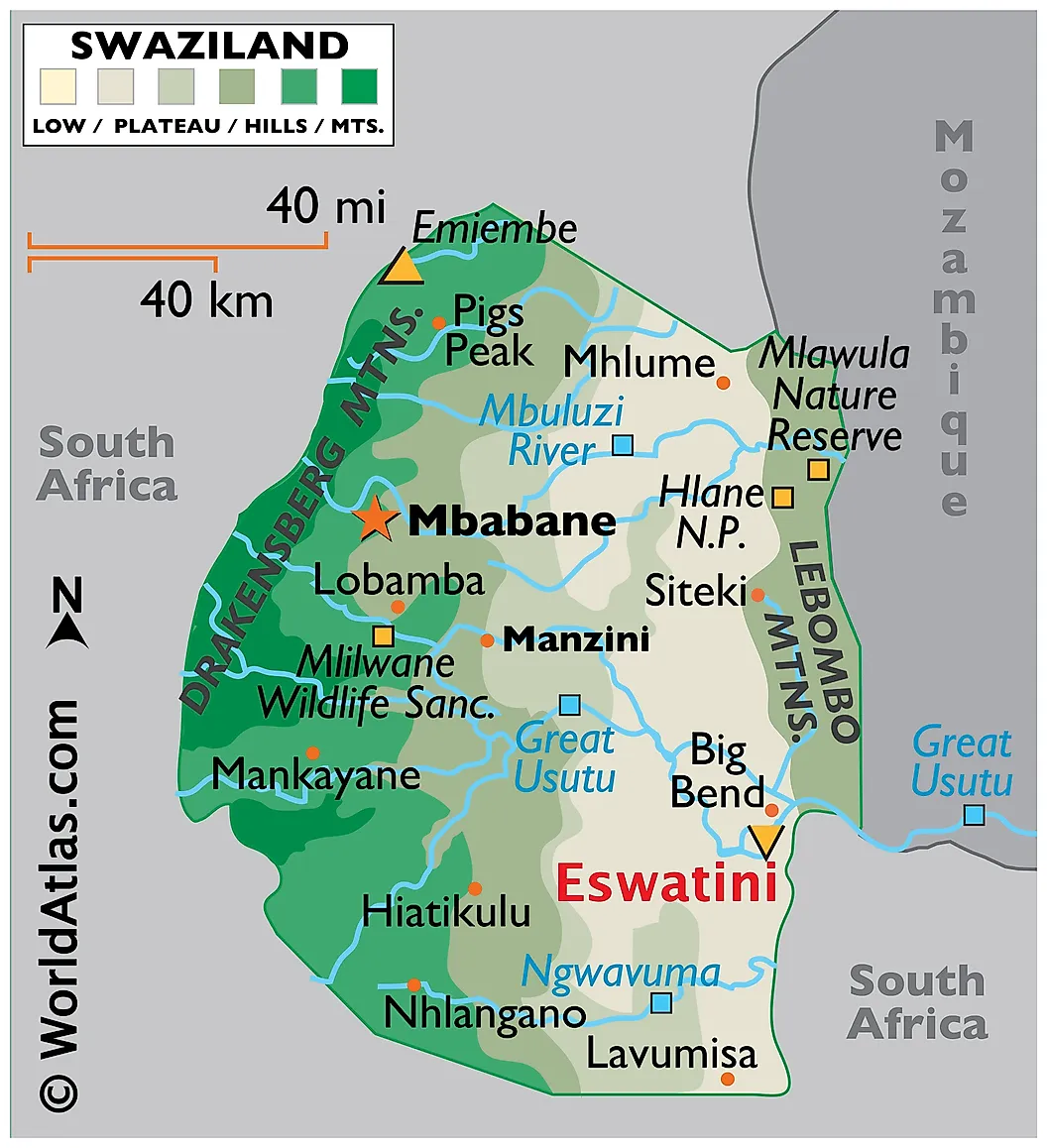
About Eswatini
- Formerly Swaziland, the nation was renamed Eswatini in 2018 to reflect its pre-colonial identity.
- King Mswati III, in power since 1986, is Africa’s last absolute monarch, ruling entirely by decree.
- Capitals and Governance:
- Administrative & judicial capital: Mbabane
- Legislative capital: Lobamba, located ~11 miles from Mbabane
- Official Languages: Swati (Swazi) and English
- Currency: Emalangeni
- Eswatini is a landlocked country in Southern Africa, located in both the Eastern and Southern Hemispheres.
- Bordered by: South Africa (to the north, west, and south), Mozambique (to the northeast).
- Major perennial rivers originate in South Africa and flow through Eswatini to the Indian Ocean: Lomati, Komati, Umbuluzi, and Usutu (the largest catchment in the country).
- In the south, the Ingwavuma River originates in western Eswatini and cuts through the Lubombo escarpment.
- Elevation: Highest point (Emiembe 1,862 m), and lowest point (Great Usutu River 21 m).
- Climate varies from tropical to near temperate.
- Natural resources include asbestos, coal, clay, cassiterite, hydropower, forests, small gold and diamond deposits, quarry stone, and talc.
India’s Low-Carbon Development Strategy: A Long Overdue Shift Toward Net Zero
Low-Carbon Development Strategy: India’s Bold Leap Toward Net Zero by 2070
Context: India is set to unveil its first nationwide long-term low-carbon development strategy later this year. The plan, aligned with the 2070 net-zero target, will cover the period from 2040 to 2070 and is based on emission scenarios developed by a NITI Aayog-led committee formed in April 2024.
What is a Low-Carbon Development Strategy and Why Does India Need One?
- A Low-Carbon Development Strategy (LCDS) is a long-term policy framework that integrates economic growth with emissions reduction. It aligns national development with climate commitments, especially under the Paris Agreement and India’s 2070 net-zero target.
- Why India Needs It:
- India is the third-largest emitter of carbon dioxide globally (after China and the US) with a growing share of 8.3% in global emissions (EI Statistical Review of World Energy 2025).
- India’s energy demand rose by 8.8% in 2024, more than double the global average, largely powered by coal.
- India’s per capita emissions remain low, but the absolute emission growth rate outpaced China in 2024.
- According to the United Nations Framework Convention on Climate Change (UNFCCC), India lacks a consolidated carbon budgeting framework despite having initiatives like Perform, Achieve, and Trade (PAT) and Renewable Energy Certificates.
When Will India Unveil This Strategy and What Are Its Key Timelines?
Existing Indian Instruments :
- Indian Carbon Market (ICM) – Voluntary pilot under BEE.
- Carbon Credit Trading Scheme (CCTS) – Designed more for carbon border adjustment, not actual emissions reduction.
- Perform, Achieve, and Trade (PAT) – Sector-specific efficiency targets.
- A long-term low-carbon strategy is expected to be announced later in 2025, developed by a high-level committee under NITI Aayog, which was formed in April 2024.
- The plan will cover four key periods: 2040, 2050, 2060, and 2070, with 2070 being the net-zero target.
- It has taken over two years to chart scenarios for transition, emissions, GDP, jobs, and investments.
Where Does ………………………………………………000000000000000000000000000000000000000000
Stand on Carbon Budgets Compared to Other Countries?
- Unlike developed countries (e.g., EU, UK), India lacks a national carbon budget—a legally binding cap on allowable emissions across sectors.
- Developed nations have adopted such budgets to stay within the 1.5–2°C temperature limit, as per IPCC goals.
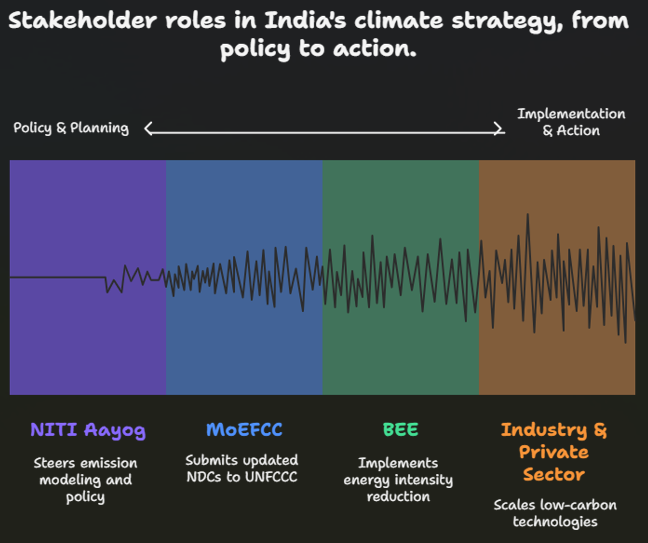
What Will the Strategy Include?
- National Carbon Budget (under consideration): To define sectoral caps and allocate emission rights.
- Multi-Decadal Emission Trajectory: For 2040, 2050, 2060, and 2070.
- Sectoral Prioritisation: Based on economic growth, employment, and sustainability metrics.
- Support for Technologies: Focus on green hydrogen, sustainable aviation fuel, and low-carbon manufacturing.
- India’s emissions rose by 4% in 2024 despite per capita emissions being low. This calls for a shift to low-carbon energy to support economic growth (EI World Energy Review 2025).
How Will This Strategy Help India Achieve Net Zero by 2070?
- Strategic Benefits:
- Long-Term Investment Signals: Provides certainty to investors on sustainable pathways.
- Policy Coherence: Aligns climate action with GDP growth, energy demand, and employment.
- Avoiding Carbon Lock-In: Prevents infrastructure investment in high-emission sectors.
- Institutional Impact:
- Will strengthen India’s position in global climate negotiations.
- Helps meet Article 4 of the Paris Agreement – Long-term low-emission development strategies.
Subscribe to our Youtube Channel for more Valuable Content – TheStudyias
Download the App to Subscribe to our Courses – Thestudyias
The Source’s Authority and Ownership of the Article is Claimed By THE STUDY IAS BY MANIKANT SINGH


